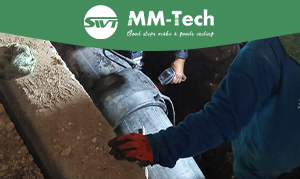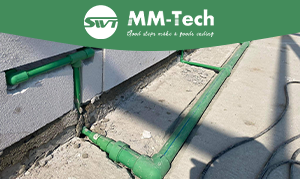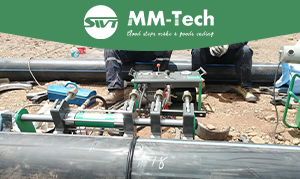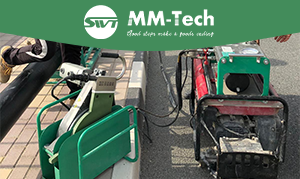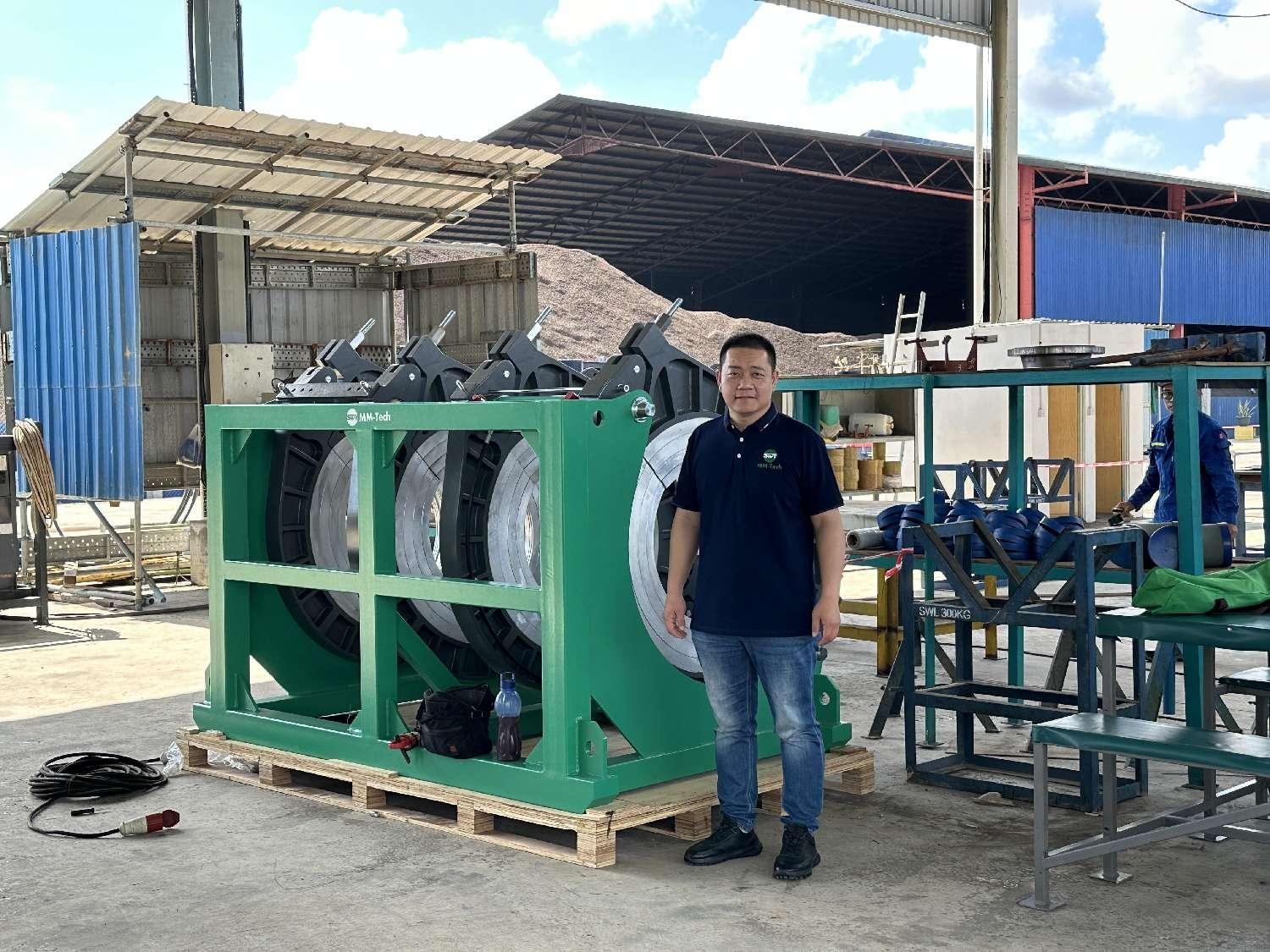Butt welding machines play a vital role in industries where strong and precise joints are essential. The market for these machines is projected to reach USD 400 million by 2025, driven by demand in construction and water treatment. Automation has enhanced their efficiency, with features like compatibility with robotic systems and improved productivity. MM-Tech, a leading butt welding machine manufacturer, offers innovative solutions like the butt fusion machine to meet modern needs.
Key Takeaways
Butt welding machines help make strong and accurate joints. They are used in industries like building and car-making. Buying a good machine makes work reliable and fast.
New technology is changing butt welding machines. Smart features and automation make them work better and faster. This is great for big projects.
Taking care of butt welding machines is very important. Cleaning, oiling, and checking parts can make them last longer. It also stops expensive fixes.
Overview of Butt Welding Machines
What Are Butt Welding Machines?
A butt welding machine is a specialized tool designed to join two pieces of material, typically metal or plastic, along their edges. These machines create a seamless connection by heating the edges until they melt and then applying pressure to fuse them together. You’ll find that they consist of several essential components, including a clamping mechanism to hold the materials in place, a heating element to melt the edges, and a control system to adjust welding parameters. Some advanced models, like CNC butt welding machines, offer precise automation for enhanced accuracy.
The primary functions of these machines include:
Joining: Seamlessly connecting two pieces of material.
Sealing: Providing leak-proof and airtight seals, ideal for industries like plumbing and automotive.
Strength Enhancement: Improving the mechanical strength of the joint.
Consistency: Delivering repeatable and uniform welds with minimal defects.
Modern designs incorporate robust frames for stability, adjustable clamps for precise alignment, and cooling systems to prevent overheating. These features ensure that you can achieve high-quality welds efficiently and safely.
Importance in Modern Industries
Butt welding machines play a critical role in various industries. Their ability to create strong, precise, and durable joints makes them indispensable. For example, in pipeline construction, they ensure reliable connections for transporting water or gas. In the automotive sector, they help manufacture exhaust systems and body panels, enhancing both safety and performance. Industries like aerospace and shipbuilding also rely on these machines for joining structural components with precision.
You’ll notice that these machines stand out for their versatility. They work with a wide range of materials, including metals and plastics, making them suitable for diverse applications. Additionally, their efficiency reduces production time and material waste, which helps lower costs. Whether you’re in construction, manufacturing, or infrastructure development, investing in a high-quality butt welding machine from a trusted butt welding machine manufacturer ensures long-term value and performance.
Key Features and Components of Butt Welding Machines
Machine Body and Frame
The body and frame of a butt welding machine form its backbone. These structural features ensure stability and durability during operations. A robust frame, often made from high-quality steel, minimizes vibrations and enhances precision. The adjustable clamping mechanism secures workpieces, allowing you to achieve high docking accuracy. This mechanism ensures consistent joint alignment, which is critical for quality welds.
The machine’s welding head assembly provides precise electrode positioning, while the cooling system prevents overheating during extended use. Many models also include a user-friendly control panel, giving you easy access to adjust parameters and monitor progress. For added convenience, mobility and portability features, such as wheels or casters, allow you to move the machine effortlessly within your workspace.
Component | Description |
|---|---|
Robust Frame Construction | Made from high-quality materials like steel for stability and durability during welding operations. |
Adjustable Clamping Mechanism | Secures and aligns workpieces for accurate fit-up and consistent joint alignment. |
Welding Head Assembly | Designed for precise electrode positioning and movement, with controls for welding parameters. |
User-Friendly Control Panel | Provides easy access to adjust parameters and monitor progress, enhancing operability. |
Cooling System | Prevents overheating during welding, ensuring continuous operation. |
Safety Features | Includes emergency stop buttons, interlocks, and protective guards for operator safety. |
Mobility and Portability | Features wheels or casters for easy movement within workshops or job sites. |
Automation Compatibility | Allows integration into automated systems for improved productivity. |
Trimmer and Heater
The trimmer and heater are essential components of butt welding machines. The trimmer prepares the edges of the materials by removing irregularities, ensuring a smooth surface for welding. A high-quality trimmer tool, driven by a stable motor, guarantees consistent performance. The heater, often coated with Teflon, melts the edges of the materials, enabling a seamless fusion.
Modern machines, like those offered by a leading butt welding machine manufacturer, include digital temperature controls. These controls allow you to maintain precise heating levels, which is crucial for achieving strong and durable joints. The combination of a reliable trimmer and an efficient heater ensures that your welding process is both accurate and efficient.
Control Unit and Automation Features
The control unit is the brain of a butt welding machine. It allows you to set and monitor welding parameters with ease. Advanced models, including CNC butt welding machines, feature programmable options that enhance accuracy and efficiency. These machines let you customize welding programs to suit different materials and techniques.
Automation compatibility is another key feature. It enables integration with robotic systems, reducing setup times and improving productivity. Real-time monitoring and quality assurance features ensure consistent results. With a user-friendly control panel, you can easily navigate these advanced functions, making the welding process more streamlined and effective.
Safety Features and Standards
Safety features are vital for protecting operators and ensuring smooth operations. Modern butt welding machines include emergency stop buttons, interlocks, and protective guards. These features minimize risks and create a safer working environment.
To maintain safety, you should follow industry standards. Conduct regular inspections, ensure proper alignment of workpieces, and monitor the cooling system to prevent overheating. Comprehensive training for operators is also essential. By adhering to these guidelines, you can maximize the safety and reliability of your welding machines.
Tip: Always keep a clean and hazard-free workspace to enhance safety and efficiency during welding operations.
Types of Butt Welding Machines by MM-Tech
Manual Butt Welding Machines
Manual butt welding machines are ideal for small-scale projects and repair work. These machines require you to manually control the welding process, making them simple to operate and maintain. They are perfect for applications where precision and speed are not the primary concerns. MM-Tech’s manual butt fusion machine, for instance, offers a reliable solution for joining PE, PP, PPR, and PVDF pipes. Its straightforward design ensures ease of use, even for beginners.
You’ll find that these machines are lightweight and portable, making them convenient for on-site repairs. Their affordability also makes them a cost-effective choice for professionals working on smaller projects. While they lack the advanced features of automated models, manual machines provide consistent performance for basic welding tasks.
Semi-Automatic Butt Welding Machines
Semi-automatic butt welding machines strike a balance between manual control and automation. These machines require you to input parameters like temperature and pressure, but they handle the welding process with greater precision. This combination makes them suitable for medium-scale projects where efficiency and quality are essential.
MM-Tech’s semi-automatic models offer several advantages:
High Welding Efficiency: Faster welding cycles save time.
Superior Weld Quality: Controlled heat input ensures strong and durable joints.
Versatility: Compatible with various materials, including metals and plastics.
Cost-Effectiveness: Reduced material waste lowers overall costs.
These machines also feature enhanced safety mechanisms, ensuring secure operations. Their ability to integrate with automation systems further boosts productivity, making them a versatile choice for industrial applications.
Fully Automatic Butt Welding Machines
Fully automatic butt welding machines represent the pinnacle of welding technology. These machines require minimal operator input, allowing you to focus on overseeing the process rather than managing every detail. MM-Tech’s fully automatic models use advanced features like digital display recorders and programmable settings to deliver unmatched precision.
You’ll appreciate their ability to handle large-scale projects with ease. The robust frame and adjustable clamping mechanisms ensure stability, while the user-friendly control panel simplifies operation. These machines excel in applications requiring high precision, such as pipeline construction and industrial manufacturing. By automating the welding process, they reduce errors and improve overall efficiency.
Tip: Fully automatic machines are perfect for projects where consistency and speed are critical. Their advanced features make them a valuable investment for professionals seeking top-tier performance.
Working Methods and Operating Procedures
Heating and Joining Process
The heating and joining process forms the core of the butt fusion welding technique. To achieve a strong and durable joint, you must follow a series of precise steps:
Heating Techniques: Choose the appropriate method, such as resistance heating or induction heating, based on the material’s properties.
Temperature Control: Maintain the correct temperature to prevent overheating or underheating, which can weaken the joint.
Heating Duration: Monitor the heating time carefully. Insufficient heating can result in weak bonds, while excessive heating may damage the material.
Material Considerations: Understand the unique properties of the material you are welding. Metals and plastics require different approaches during the butt fusion process.
Pressure Application: Apply consistent pressure during heating to ensure the materials fuse seamlessly.
By following these steps, you can create high-quality hot-melt butt joints that meet industry standards. The precision of the heating process directly impacts the strength and durability of the butt fusion jointing.
Steps for Safe and Efficient Operation
Operating a butt welding machine safely and efficiently requires adherence to best practices. Here’s how you can ensure optimal performance:
Conduct a thorough inspection of the machine before each use. Check all components, including the trimmer and heater, for proper functionality.
Train all operators on the correct use of the manual butt fusion machine and its safety features.
Align the workpieces accurately to achieve a seamless joint. Misalignment can compromise the quality of the weld.
Set the welding parameters, such as temperature and pressure, according to the material specifications.
Monitor the cooling system during operation to prevent overheating.
Maintain a clean workspace to avoid contamination during the butt fusion process.
Perform post-weld inspections to verify the integrity of the joint.
Regular maintenance also plays a crucial role in ensuring the machine’s longevity. Clean the components, lubricate moving parts, and inspect the heating elements for wear. These steps not only enhance safety but also improve the efficiency of the butt welding machine.
Tip: Keep detailed records of machine usage and maintenance activities. This practice helps identify potential issues early and ensures consistent performance.
Applications and Usage Areas of Butt Welding Machines
Industries That Rely on Butt Welding Machines
Butt welding machines are indispensable across a variety of industries due to their ability to create strong and precise joints. You’ll find these machines particularly valuable in the following sectors:
Pipeline Construction: These machines join sections of pipelines, ensuring reliable connections for transporting water, gas, or other fluids.
Aerospace: They play a critical role in joining structural components, enhancing both integrity and weight reduction.
Automotive: Butt welding machines are essential for manufacturing exhaust systems and body panels, improving safety and performance.
Shipbuilding: They provide strong and durable connections for metal components, ensuring the structural stability of ships.
Metal Fabrication: These machines create precision-welded structures, meeting the demands of various industrial applications.
Construction and Utilities: In these sectors, they are widely used for joining polyethylene pipes and fittings, especially in gas and water distribution systems.
By investing in a high-quality butt welding machine, you can ensure efficiency and reliability in these demanding industries.
Common Materials Used (e.g., Metals, Plastics)
Butt welding machines are compatible with a wide range of materials, each offering unique properties that make them suitable for specific applications. Here’s a breakdown of commonly used materials:
Property | Description |
|---|---|
Material Compatibility | Suitable for materials like PE, PP, PPR, PVDF, copper, aluminum, and alloys. |
Conductivity | High electrical conductivity ensures smooth current flow, generating the necessary heat for welding. |
Heat Transfer | Efficient heat transfer enables uniform melting and fusion of workpieces. |
Longevity | High-quality materials reduce wear and replacement frequency, ensuring long-term performance. |
Electrode Size | Influences heat input and weld bead width, affecting the characteristics of the joint. |
For plastic applications, you’ll often encounter materials like PE and PP, which are ideal for hdpe pipe fusion. Metals like aluminum and copper are also common in industrial projects. Whether you’re using an hdpe pipe fusion machine or an hdpe pipe joint machine, understanding the material properties ensures optimal results.
Tip: Always match the material type with the appropriate machine settings to achieve strong and durable butt fusion joints.
Advancements and Trends in Butt Welding Machines in 2025
Automation and Smart Features
Automation is revolutionizing butt welding machines in 2025. You’ll notice that modern machines now integrate seamlessly with robotic systems, enhancing productivity and repeatability. These advancements allow you to achieve unmatched accuracy in your welding projects. CNC butt welding machines, for instance, offer programmable settings that simplify complex tasks.
Smart features are also becoming standard. Machines now include data analytics tools that help you monitor and improve future welds. Artificial intelligence is opening new possibilities, enabling machines to adapt to different materials and welding conditions automatically. This shift toward automation compatibility ensures that you can handle large-scale projects efficiently while maintaining consistent joint quality.
Additionally, the market is moving toward sustainability. Many machines now feature energy-efficient designs, reducing power consumption without compromising performance. These innovations not only save costs but also align with eco-friendly practices, making them a smart choice for modern industries.
Portability and Compact Designs
Portability is another key trend shaping butt welding machines. Many models now include wheels or casters, allowing you to move them easily within workshops or job sites. Compact designs make these machines ideal for tight spaces, ensuring you can work efficiently even in challenging environments.
Lightweight materials and foldable structural features further enhance mobility. These advancements make it easier for you to transport the machine to different locations, saving time and effort. Whether you’re working on a pipeline installation or an on-site repair, portable machines provide the flexibility you need to complete your tasks effectively.
Enhanced Safety and Efficiency
Safety features have seen significant improvements in 2025. Modern machines now include emergency stop buttons, safety interlocks, and automatic shutdown systems. These features protect you from potential hazards, ensuring a safer working environment.
Efficiency has also improved with robust frame construction and adjustable clamping mechanisms. These structural features provide stability during operation, allowing you to achieve precise alignment for every joint. User-friendly control panels and automation compatibility further streamline the welding process, reducing errors and boosting productivity.
By investing in machines with advanced safety features, you can focus on your work with confidence. These innovations not only enhance safety but also ensure that your projects meet the highest standards of quality and efficiency.
Pricing and Maintenance Considerations for Butt Welding Machines
Factors Affecting Pricing
The cost of butt welding machines depends on several factors. The type of machine plays a significant role. Manual models are more affordable, while fully automatic machines with advanced features cost more. The size and capacity of the machine also influence pricing. Machines designed for larger pipe diameters require more robust components, which increases their price.
Materials used in construction impact the cost as well. Machines with high-quality steel frames and durable heating elements tend to be more expensive. Additional features, such as an adjustable clamping mechanism or a user-friendly control panel, also add to the price. These features enhance precision and ease of use, making them valuable for professionals.
Brand reputation and certifications further affect pricing. Trusted manufacturers like MM-Tech offer machines that meet international standards, ensuring reliability and safety. While these machines may cost more upfront, they provide long-term value through durability and performance.
Maintenance Tips for Longevity
Proper maintenance ensures your butt welding machine operates efficiently for years. Follow these essential practices to extend its lifespan:
Clean all surfaces regularly to remove debris that could affect performance.
Lubricate moving parts to reduce wear and maintain smooth operation.
Inspect and tighten electrical connections to prevent malfunctions.
Check cooling systems to avoid overheating during extended use.
Calibrate the user-friendly control panel to ensure accurate welding parameters.
Examine heating elements for wear to maintain weld quality.
Test safety features like emergency stops and interlocks to protect operators.
Assess weld quality periodically to identify potential issues early.
Train operators to use the machine correctly and perform routine maintenance.
By following these steps, you can maximize the efficiency and lifespan of your machine. Regular maintenance not only prevents costly repairs but also ensures consistent weld quality for your pipe projects.
Butt welding machines have become indispensable for industries like construction, automotive, and energy. Advancements in automation and design, such as user-friendly control panels and intuitive programming, make these machines more accessible. By choosing a trusted butt welding machine manufacturer like MM-Tech, you ensure precision, efficiency, and long-term value for your pipe welding needs.
FAQ
1. What materials can you weld with a butt welding machine?
You can weld materials like PE, PP, PPR, PVDF, aluminum, and copper. These machines work well with both plastics and metals, ensuring strong and durable joints.
2. How do you maintain a butt welding machine?
Clean surfaces regularly.
Lubricate moving parts.
Inspect heating elements.
Test safety features.
Train operators for proper use.
Tip: Regular maintenance ensures consistent performance and extends the machine’s lifespan.
3. Can you use a butt welding machine for on-site projects?
Yes! Many machines, especially portable models, are designed for on-site use. Lightweight frames and wheels make them easy to transport and operate in tight spaces.
:wrench: Pro Tip: Choose a compact design for maximum mobility during fieldwork.


